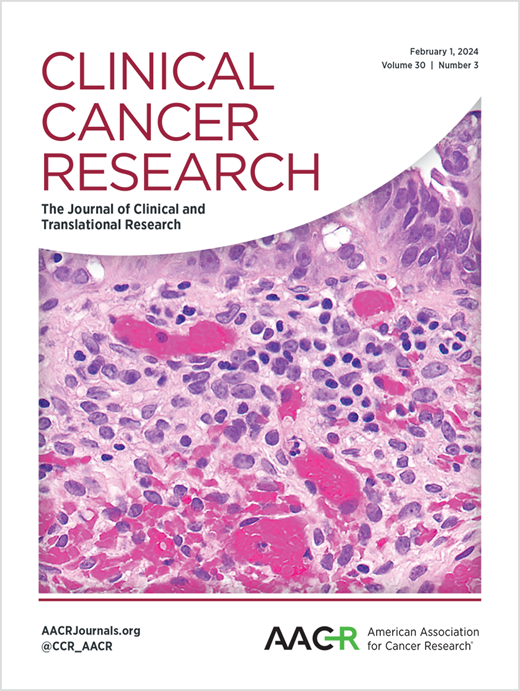ErbB2信号的增加是对雄激素信号抑制的早期适应,并在去势抵抗性前列腺癌中持续存在。
IF 10.2
1区 医学
Q1 ONCOLOGY
引用次数: 0
摘要
目的erbb2活性在前列腺癌(PCa)的一个亚群中升高,但该基因很少被扩增。本研究旨在确定驱动ErbB2活性增加的机制及其在去势抵抗性前列腺癌(CRPC)进展中的作用。采用免疫组织化学(IHC)、反相蛋白阵列和RNA测序技术,在细胞系、异种移植物和临床肿瘤中对EXPERIMENTAL DESIGNErbB2信号进行了研究。对ErbB2抑制剂进行了体外和体内敏感性测试。结果ErbB2磷酸化抗体经免疫组化检测,在新辅助雄激素信号抑制(ASI)后根治性前列腺切除术(RPs)和晚期CRPC中约26%的残余肿瘤中存在serbb2活化。免疫组化法在75%的新佐剂治疗肿瘤中发现ErbB3/ErbB2激活配体NRG1。在PCa细胞和异种移植物中,ASI快速增加了NRG1 mRNA,在ASI后数据集中也增加了。活性ERBB2剪接变异体(d16ERBB2)的过表达也在PCa细胞ASI后迅速增加,并在CRPC的一个亚群中发现。ErbB2信号在所有模型中对共价ErbB2抑制剂neratinib保持敏感,这增强了对去势的反应,抑制了ErbB2激活的去势抵抗异种移植物的生长。结论ErbB2信号的增加是对ASI的快速适应,并有助于去势抵抗。NRG1和d16ERBB2的增加有助于ErbB2信号的增加。强效ErbB2拮抗剂可能会增强去势敏感PCa对ASI的反应,ErbB2磷酸化可能是CRPC中肿瘤反应的生物标志物。本文章由计算机程序翻译,如有差异,请以英文原文为准。
Increased ErbB2 signaling is an early adaptation to androgen signaling inhibition and persists in castration resistant prostate cancer.
PURPOSE
ErbB2 activity is increased in a subset of prostate cancer (PCa), but the gene is rarely amplified. This study sought to identify mechanisms driving increased ErbB2 activity and their role in progression to castration resistant prostate cancer (CRPC).
EXPERIMENTAL DESIGN
ErbB2 signaling was interrogated with a combination of immunohistochemistry (IHC), reverse-phase protein array, and RNA sequencing in cell lines, xenografts, and clinical tumors at various stages of castration resistance. Sensitivity to ErbB2 inhibitors was tested in vitro and in vivo.
RESULTS
ErbB2 activation, identified by IHC with an antibody against phosphorylated ErbB2, was present in ~26% of residual tumors in radical prostatectomies (RPs) after neoadjuvant androgen signaling inhibition (ASI) and in advanced CRPC. The ErbB3/ErbB2 activating ligand NRG1 was found by IHC in ~75% of neoadjuvant-treated tumors. NRG1 mRNA was rapidly increased by ASI in PCa cells and xenografts and was increased in post-ASI data sets. Overexpression of an active ERBB2 splice variant (d16ERBB2) was also increased rapidly after ASI in PCa cells and was found in a subset of CRPC. ErbB2 signaling in all models remained sensitive to the covalent ErbB2 inhibitor neratinib, which enhanced responses to castration and suppressed the growth of castration-resistant xenografts with ErbB2 activation.
CONCLUSIONS
Increased ErbB2 signaling is a rapid adaptation to ASI and contributes to castration resistance. Increases in NRG1 and d16ERBB2 contribute to increased ErbB2 signaling. Potent ErbB2 antagonists may enhance responses to ASI in castration-sensitive PCa, and ErbB2 phosphorylation may be a biomarker for tumors that will respond in CRPC.
求助全文
通过发布文献求助,成功后即可免费获取论文全文。
去求助
来源期刊

Clinical Cancer Research
医学-肿瘤学
CiteScore
20.10
自引率
1.70%
发文量
1207
审稿时长
2.1 months
期刊介绍:
Clinical Cancer Research is a journal focusing on groundbreaking research in cancer, specifically in the areas where the laboratory and the clinic intersect. Our primary interest lies in clinical trials that investigate novel treatments, accompanied by research on pharmacology, molecular alterations, and biomarkers that can predict response or resistance to these treatments. Furthermore, we prioritize laboratory and animal studies that explore new drugs and targeted agents with the potential to advance to clinical trials. We also encourage research on targetable mechanisms of cancer development, progression, and metastasis.
 求助内容:
求助内容: 应助结果提醒方式:
应助结果提醒方式:


